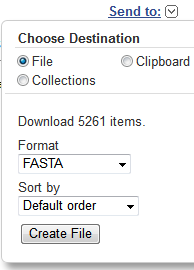For example, in taxonomy-based tools such as Kraken, mapping
1) taxonomy id to sequence id (gi or accession) and
2) taxonomy id to a human-readable taxonomy tree,
are built-in and transparent to the user.
Unfortunately, with BLAST+ these steps must be completed manually and are included in two separate programs,
makeblastdb for (1) and blastn/blastp/blastx for (2). (1) Taxonomy id <–> sequence id
In BLAST+, a taxid_map file file must be created and passed to makeblastdbmakeblastdb -in <FASTA file> -dbtype nucl -parse_seqids -taxid_map taxid_map.txt For example, with gi:
taxid_map.txtAlternatively with accession:
556927176 4570
556926995 4573
501594995 3914
taxid_map.txtThere is no turn-key way to generate this mapping
NC_022714.1 4570
NC_022666.1 4573
NC_021092.1 3914
taxid to sequence_id for a moderately large set of sequencing.- Creating a look-up dictionary from the complete NCBI taxonomy database is memory prohibitive.
- Entrez API calls are capped at 3 per second.
sequence_id and taxid. They can both be obtained from the NCBI, searching and exporting with Send to: 
This simple Python code snippet will do the trick for small and moderately large datasets.
from Bio import SeqIO
genbankfile = "DNA.gb"
f = open('taxid_map.txt','w')
for gb in SeqIO.parse(genbankfile,"gb"):
try:
annotations = gb.annotations['gi']
taxid = gb.features[0].qualifiers['db_xref'][0].split(':')[1]
f.write("{} {}\n".format(annotations, taxid))
except:
pass
f.close()Download both the FASTA and GenBank, alternatively extract the FASTA from GenBank, e.g. with BioPython.
(2) Taxonomy id <–> Taxonomy tree
Simply include this NCBI database in the same directory as your database for the look-up to work withblastn/blastp/blastx: ftp://ftp.ncbi.nlm.nih.gov/blast/db/taxdb.tar.gzEating your cake
blastn -db <DATABASE> -query <QUERY> -outfmt "10 qseqid sseqid pident staxids sscinames scomnames sblastnames sskingdoms"
1,gi|312233363|ref|NC_014692.1|,86.26,310261,Sus scrofa taiwanensis,Sus scrofa taiwanensis,even-toed ungulates,EukaryotaYour comma separated file (
1,gi|223976078|ref|NC_012095.1|,86.26,9825,Sus scrofa domesticus,domestic pig,even-toed ungulates,Eukaryota
1,gi|5835862|ref|NC_000845.1|,86.26,9823,Sus scrofa,pig,even-toed ungulates,Eukaryota
-outfmt) showing human-readable taxonomy info.


2 comments:
Hi, it was really nice but unfortunately I am unable to have a taxon id in BLAST output. It says N/A. I have downloaded FASTA sequences and I am doing BLAST all vs all.
makeblastdb -in file.fasta -db prot -out ./database/db
TaxDB is in the same folder of BLAST database. BLAST query:
blastp -db ./database/db -query file.fasta -out results.out -outfmt "6 qseqid sseqid pident length mismatch gapopen qstart qend staxid sscinames scomnames stitle sstart send evalue bitscore"
Any suggestions? Your help will be appreciated.
Very helpful post! Thanks a million!
You may also want to add a test like this, to make sure that the taxid is what you think it is, rather than some sort of numbder from the Human Microbiome Project or ATCC. I ran into a couple of those in my set of genbank files.
if gb.features[0].qualifiers['db_xref'][0].split(':')[0] == "taxon":
taxid = gb.features[0].qualifiers['db_xref'][0].split(':')[1]
Post a Comment